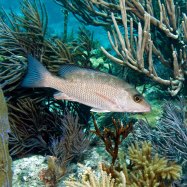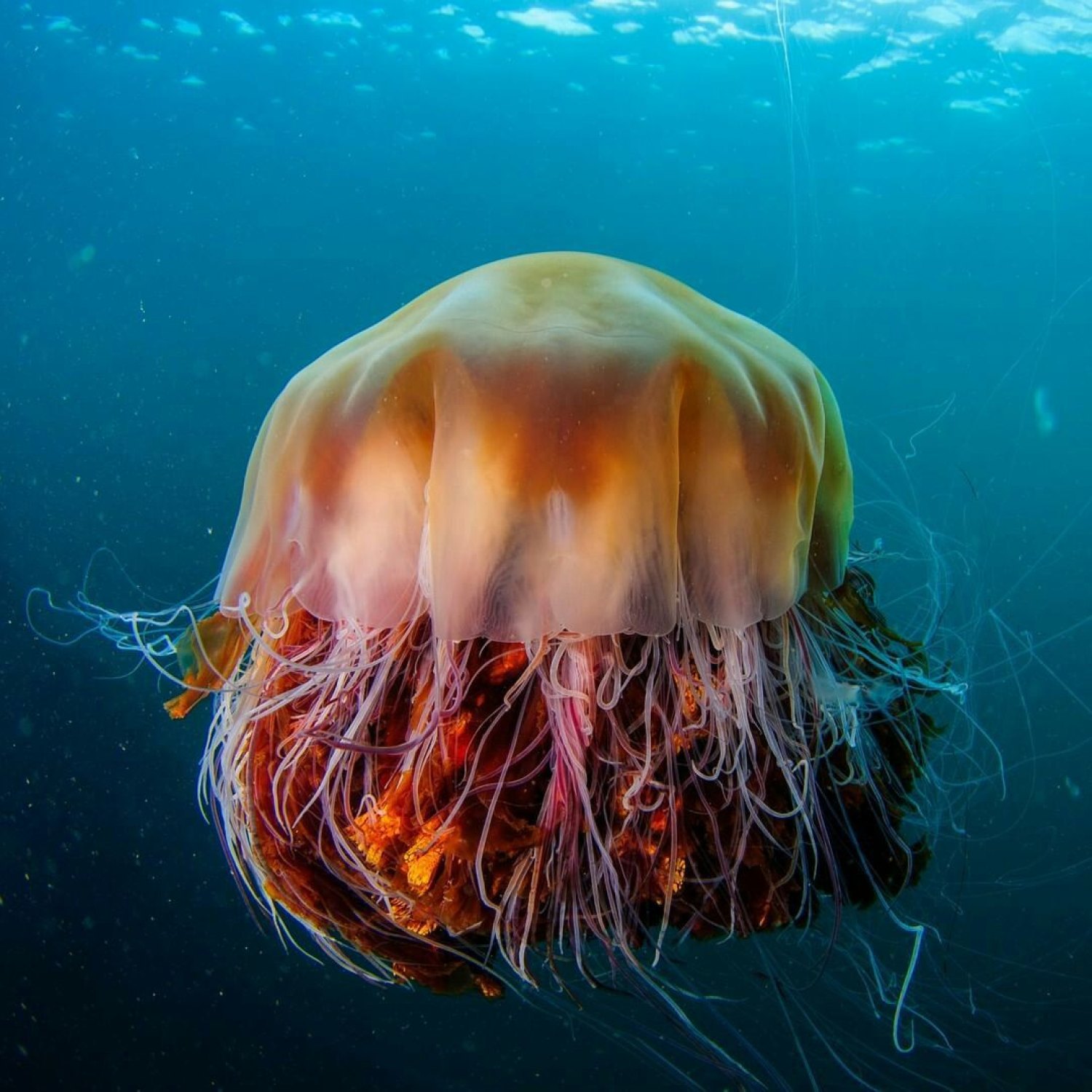
Lions Mane Jellyfish
Up to 120 feet (36.6 meters) with tentacles
The Lions Mane Jellyfish, known for its umbrella-like body and long tentacles, can reach lengths of up to 120 feet. The Cyaneidae family dwells in coastal waters and is one of the largest jellyfish species. Don't let their beauty fool you, their stings can be painful. #jellyfish #creaturefeature #oceanlife
Animal Details Summary:
Common Name: Lion's Mane Jellyfish
Kingdom: Animalia
Habitat: Marine
The Magnificent Lion's Mane Jellyfish: Exploring the Wonders of the Ocean
The ocean is a vast and mysterious world, home to countless species of marine life. Among these creatures is the majestic Lion's Mane Jellyfish, known for its striking appearance and impressive size. With its long tentacles and unique coloration, this species has captivated the attention of scientists and ocean enthusiasts for centuries.Also known as Cyanea capillata, the Lion's Mane Jellyfish is a member of the cnidaria phylum, which includes other jellyfish, corals, and sea anemones Lions Mane Jellyfish. It is the largest jellyfish in the world, with a body that can reach up to 120 feet (36.6 meters) in length, making it longer than a blue whale, the largest mammal on earth. Its impressive size is just one of the many fascinating facts about this mysterious creature.
The Kingdom of the Lion's Mane Jellyfish
Lion's Mane Jellyfish belongs to the Animalia kingdom, which encompasses all animals on earth. This kingdom is divided into various phyla, and the Lion's Mane Jellyfish falls under the phylum Cnidaria. These creatures are classified as invertebrates, meaning they do not have a backbone or spinal cord.Cnidarians are known for their radial symmetry, meaning their body parts are arranged in a circular pattern around a central point. This symmetry is visible in the Lion's Mane Jellyfish, with its umbrella-like body shape and long tentacles that radiate outwards.
Discovering the Scyphozoan Class
Within the Cnidaria phylum, the Lion's Mane Jellyfish belongs to the Scyphozoa class, along with other true jellyfish species Ladyfish. These animals are distinguished by their bell-shaped bodies and stinging tentacles, which they use to catch prey and defend themselves against predators.Scyphozoans undergo two main life stages: the medusa stage, where they take on their bell-shaped form, and the polyp stage, where they resemble small plants attached to rocks or other surfaces. The Lion's Mane Jellyfish spends most of its life as a medusa, only turning into a polyp during its early stages of development.
The Society of Semaeostomeae
Lion's Mane Jellyfish belongs to the Semaeostomeae order, which includes other true jellyfish species such as the moon jellyfish and the blue jellyfish. These creatures are easily recognizable by their translucent bodies and long, flowing tentacles.One of the defining characteristics of the Semaeostomeae order is their feeding method. They are all carnivorous, meaning they feed on other animals for sustenance. The Lion's Mane Jellyfish uses its tentacles to catch small fish, shrimp, and other sea creatures, which it then consumes through its oral arms located at the center of its body.
The Royal Family of Cyaneidae
Within the Semaeostomeae order, the Lion's Mane Jellyfish belongs to the Cyaneidae family, which contains other large jellyfish species. These creatures are commonly found in the colder waters of the Northern Atlantic and Pacific Oceans, making them a common sight in coastal areas of the United Kingdom, where they originated.One distinct feature of the Cyaneidae family is their large size and unique coloration. While most jellyfish are translucent, the Lion's Mane Jellyfish has a pale pink or yellowish-orange coloration, giving it a regal appearance. Its long, flowing tentacles have a translucent, almost transparent appearance, making it a sight to behold in the ocean.
The Habitat of the Lion's Mane Jellyfish
Being a marine creature, the Lion's Mane Jellyfish is confined to the ocean, specifically in coastal waters. They can be found in the shallow waters of the Northern Atlantic and Pacific Oceans, where the water is colder and the food supply is plentiful. These creatures tend to stay closer to the surface of the water, making them a common sight for beachgoers and fishermen.However, the Lion's Mane Jellyfish can also be found in deeper waters, reaching depths of up to 8,200 feet (2,500 meters). They are known to migrate vertically, moving to shallower waters at night to feed and then deeper waters during the day to avoid predators.
The Life of a Carnivore
As mentioned earlier, the Lion's Mane Jellyfish is a carnivore, meaning it feeds on other animals to survive. They use their long tentacles to capture their prey, which they then paralyze with their stinging cells, also known as nematocysts. These cells release toxins that paralyze or kill their prey, making it easier for the jellyfish to consume them.The Lion's Mane Jellyfish is an opportunistic feeder, meaning it will eat almost anything that comes in contact with its tentacles. This includes small fish, shrimp, and even other jellyfish. They are also known to consume copepods, tiny crustaceans that are essential to the ocean's food chain.
The Global Distribution of the Lion's Mane Jellyfish
Despite its name, the Lion's Mane Jellyfish can be found in various parts of the world, including the United Kingdom, United States, Canada, and even Japan. However, they are more commonly found in the colder waters of the Northern Atlantic and Pacific Oceans, where their food supply is abundant.Their global distribution can be attributed to their passive mobility, which relies on ocean currents and winds to transport them to different areas. This makes them a frequent visitor to coastal waters around the world, making them a popular attraction for tourists and marine enthusiasts.
From Pupae to Adult: The Journey of a Lion's Mane Jellyfish
Similar to other jellyfish species, the Lion's Mane Jellyfish has a complex life cycle that involves both sexual and asexual reproduction. Females release eggs and males release sperm into the water, where fertilization takes place. The resulting embryos develop into free-swimming larvae, known as pupae, which eventually attach themselves to a hard surface and form polyps.The polyps then undergo a process called strobilation, where they develop into tiny ephyrae, which will eventually grow into adult jellyfish. The entire process takes around 2 to 3 years, with adult Lion's Mane Jellyfish having a lifespan of up to 1 year.
The Facts and Fiction Surrounding the Sting of a Lion's Mane Jellyfish
There is a common misconception that all jellyfish have a powerful and deadly sting, but this is not entirely true for the Lion's Mane Jellyfish. While their stings can be painful and cause skin irritation, their venom is not usually fatal to humans.In fact, their sting can be beneficial to humans, as it has been used in traditional Chinese medicine for centuries to treat arthritis and other joint pain. However, it is still important to exercise caution when encountering a Lion's Mane Jellyfish, as their stings can still pose a threat to those with allergies or weak immune systems.
In Conclusion
The Lion's Mane Jellyfish is a magnificent creature that has captured the hearts and minds of people for centuries. Their impressive size, unique coloration, and mysterious nature make them a fascinating subject of study for scientists and a popular attraction for ocean enthusiasts.As we continue to explore the wonders of the ocean, it is essential to remember the importance of conserving and protecting these creatures and their habitats. The Lion's Mane Jellyfish and other marine animals play a crucial role in maintaining the balance of our ecosystem and the beauty of our oceans. Let us continue to marvel at their magnificence and work together to preserve their existence for generations to come.

Lions Mane Jellyfish
Animal Details Lions Mane Jellyfish - Scientific Name: Cyanea capillata
- Category: Animals L
- Scientific Name: Cyanea capillata
- Common Name: Lion's Mane Jellyfish
- Kingdom: Animalia
- Phylum: Cnidaria
- Class: Scyphozoa
- Order: Semaeostomeae
- Family: Cyaneidae
- Habitat: Marine
- Feeding Method: Carnivorous
- Geographical Distribution: Northern Atlantic and Pacific Oceans
- Country of Origin: United Kingdom
- Location: Coastal waters
- Animal Coloration: Translucent, pale pink, or yellowish-orange
- Body Shape: Umbrella-like
- Length: Up to 120 feet (36.6 meters) with tentacles
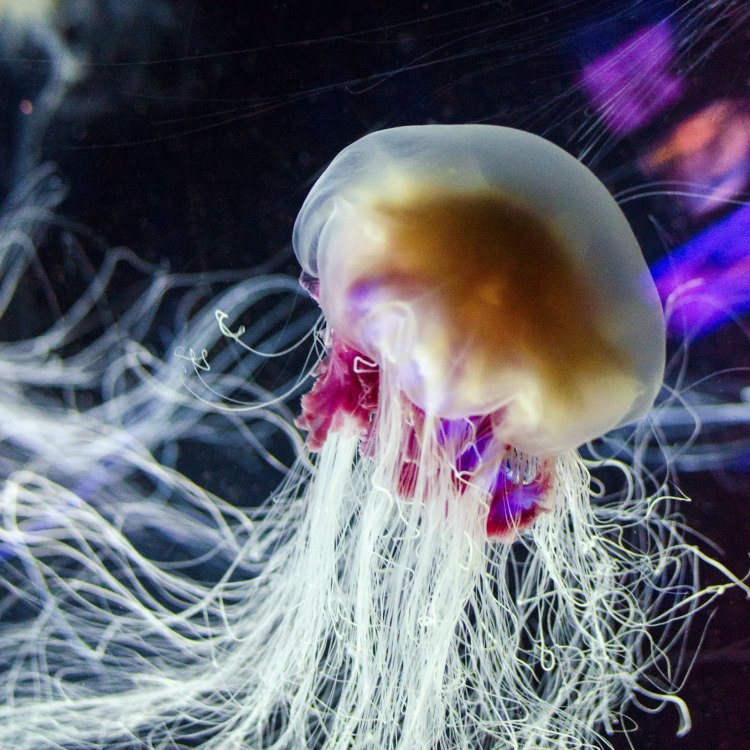
Lion's Mane Jellyfish
- Adult Size: Varies, but can be quite large
- Average Lifespan: Less than one year
- Reproduction: Sexual
- Reproductive Behavior: External fertilization
- Sound or Call: None
- Migration Pattern: Not migratory
- Social Groups: Solitary
- Behavior: Slow-moving and drifts with ocean currents
- Threats: Overfishing, pollution, climate change
- Conservation Status: Not evaluated
- Impact on Ecosystem: Predator in marine food webs
- Human Use: None
- Distinctive Features: Long and flowing tentacles
- Interesting Facts: The largest recorded lion's mane jellyfish had a bell diameter of 7.6 feet (2.3 meters) and tentacles that reached 120 feet (36.6 meters) in length. They are considered the largest jellyfish species in the world.
- Predator: Sea turtles, sunfish, and some species of fish
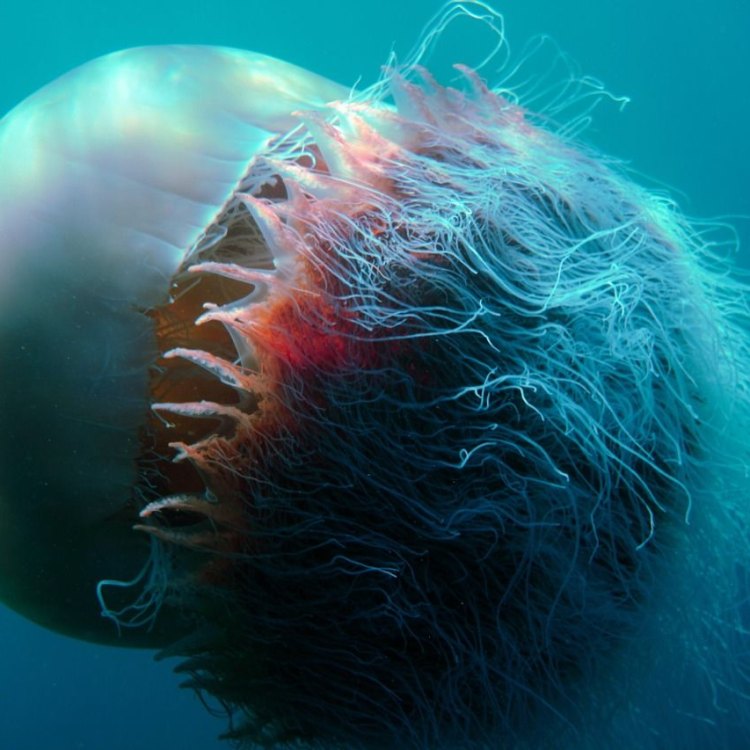
Cyanea capillata
The Enigmatic Lions Mane Jellyfish: A Gentle Giant of the Sea
The ocean is often referred to as the final frontier, a vast and mysterious world that holds many secrets and surprises. One such enigmatic creature that resides in the depths of the ocean is the lion's mane jellyfish. With its long flowing tentacles and impressive size, this unique creature has captured the curiosity and wonder of many.The lion's mane jellyfish, also known as the giant jellyfish or the hair jelly, is a magnificent underwater predator that belongs to the family Cyaneidae PeaceOfAnimals.Com. It is the largest known species of jellyfish in the world, with an adult size that can vary greatly but can be quite large. The largest recorded lion's mane jellyfish had a bell diameter of 7.6 feet (2.3 meters) and tentacles that reached a staggering 120 feet (36.6 meters) in length. To put it into perspective, that is longer than the length of an average blue whale, making the lion's mane jellyfish one of the largest creatures in the ocean.
The average lifespan of a lion's mane jellyfish is less than one year, and their reproductive behavior is sexual. They engage in external fertilization, where eggs and sperm are released into the water, resulting in fertilization. Unlike other species of jellyfish, they do not have a specific breeding season and can reproduce year-round Linnet.
While many creatures in the ocean rely on sound or calls to communicate or attract mates, the lion's mane jellyfish remains quiet. These gentle giants do not produce any sounds, making them one of the few silent creatures in the ocean.
The lion's mane jellyfish is a solitary creature, and it does not form any social groups. It is a slow-moving creature that primarily drifts with ocean currents, using its tentacles to capture its prey. They are known to be mostly passive and non-aggressive, but their venomous tentacles can still pack a punch. However, their stings are not harmful to humans and are often compared to the pain of a mild electric shock.
Being at the top of the food chain, the lion's mane jellyfish does not have many natural predators. However, they do fall prey to some species of fish, sea turtles, and sunfish. These predators are not affected by their venom and can safely consume them.
While the lion's mane jellyfish is not listed as an endangered species, it faces many threats. Overfishing has severely affected their population, as they often get tangled in fishing nets and lines. Pollution in the ocean is also a significant threat, as it can harm their delicate bodies and interfere with their reproductive process. The rise in ocean temperatures due to climate change is also a cause for concern, as it affects the plankton population, a primary food source for the lion's mane jellyfish.
Unfortunately, the conservation status of the lion's mane jellyfish is not evaluated, meaning there is little information available regarding their population and any possible decline. Research and efforts towards their protection and conservation are crucial to ensuring their survival and maintaining a healthy marine ecosystem.
The impact of the lion's mane jellyfish on the ecosystem is significant, as they are considered a predator in marine food webs. They feed on small fish, plankton, and other jellyfish, keeping their populations in check. Without them, there could be an uncontrolled growth of these creatures, leading to an imbalance in the marine ecosystem.
While the lion's mane jellyfish may be a gentle giant, it is not utilized by humans for any purposes. Unlike other jellyfish species that are used for food, medicine, or cosmetics, the lion's mane jellyfish has no known human use. However, they do attract many tourists who are fascinated by their size and beauty, and some countries have tourist facilities that feature these creatures in controlled environments.
One of the most distinctive features of the lion's mane jellyfish is its long and flowing tentacles, which can be up to hundreds of feet in length. These tentacles are used for capturing prey and are covered in specialized cells that contain venom. Their bell-shaped body can also reach an impressive size, with a range of hues from deep red to bright orange, making them truly a sight to behold.
Despite their size and unique features, there are still many mysteries surrounding the lion's mane jellyfish. Their behavior and ecology are still not entirely understood, and with the limited research and information available, there is much more to discover about this intriguing creature.
In conclusion, the lion's mane jellyfish is a majestic and awe-inspiring creature that holds a vital role in the marine ecosystem. With its impressive size, gentle nature, and distinctive features, it continues to fascinate and capture the hearts of many. However, their survival is at risk, and it is essential to raise awareness and take action to protect and conserve these gentle giants of the sea for future generations to admire and appreciate.
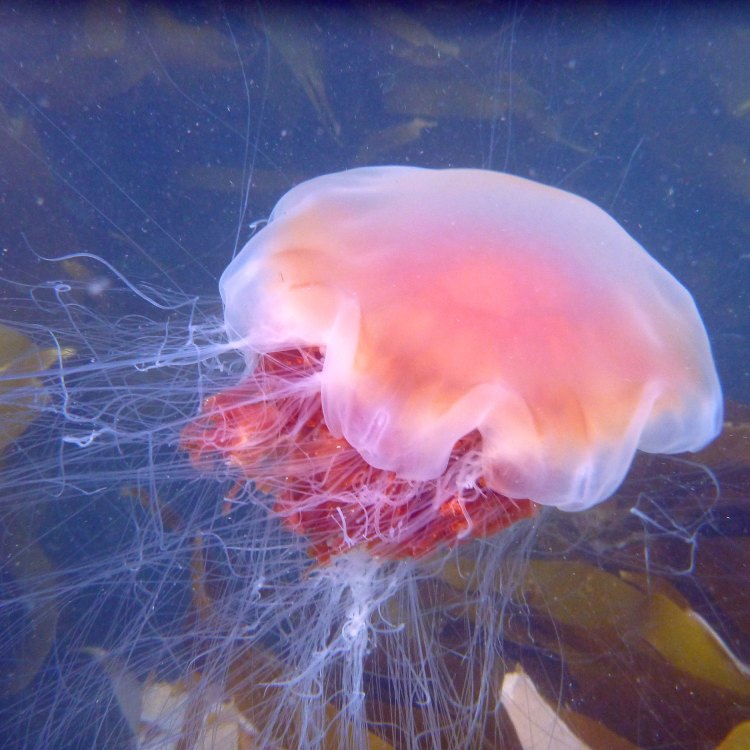
The Magnificent Lion's Mane Jellyfish: Exploring the Wonders of the Ocean
Disclaimer: The content provided is for informational purposes only. We cannot guarantee the accuracy of the information on this page 100%. All information provided here may change without prior notice.











